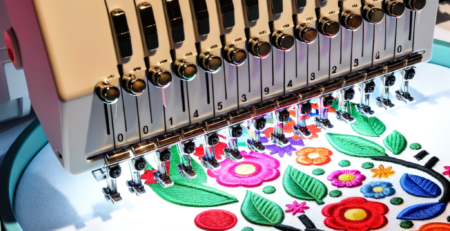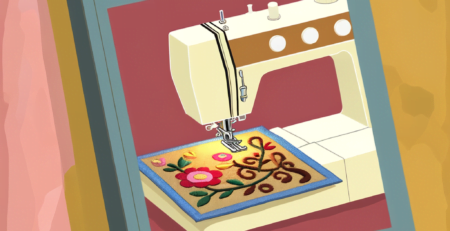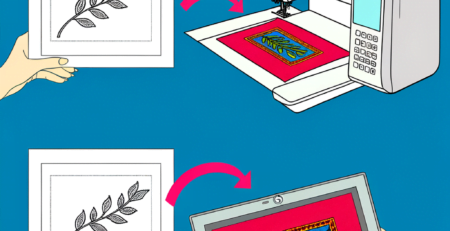Cómo asegurarse de que su archivo de bordado sea de buena calidad
Tabla de contenido
“Embroidery Excellence: Ensuring Flawless Stitches with High-Quality Files”
Introducción
Ensuring the quality of an embroidery file is crucial for achieving the best results in machine embroidery. A high-quality embroidery file will lead to a clean, precise, and visually appealing embroidered design. To achieve this, the file must be well-digitized, with attention to detail in stitch type, direction, and density. Proper planning and testing are also essential to address potential issues such as fabric distortion or thread tension problems. By taking the time to assess and refine your embroidery file before production, you can avoid common pitfalls and ensure a professional-looking outcome.
Understanding Embroidery File Formats and Their Impact on Quality
Title: How to Make Sure Your Embroidery File is Good Quality
Embroidery has long been a craft that combines the beauty of threadwork with the precision of technology. In the digital age, the quality of an embroidery project is heavily dependent on the underlying digital file. Understanding embroidery file formats and their impact on quality is crucial for anyone looking to produce professional-grade embroidered goods. This knowledge ensures that the final product reflects the care and attention to detail that went into its design.
Embroidery files are essentially blueprints for embroidery machines, instructing them on where to place stitches, which colors to use, and when to trim threads. These files come in various formats, each compatible with different types of embroidery machines. Common formats include PES for Brother machines, DST for Tajima machines, and HUS for Husqvarna machines, among others. The choice of format can significantly affect the quality of the embroidery, as each format has its own way of encoding information, which may or may not be fully compatible with the machine in use.
To ensure that your embroidery file is of good quality, it is essential to start with a high-resolution design. This means that the image or pattern you wish to embroider should be clear and detailed. A low-resolution image can result in a digitized file that lacks definition, leading to imprecise stitching and a final product that falls short of expectations. Moreover, the digitizing process, which converts your design into a stitch file, must be done with precision. Skilled digitizers understand how to map out the design in a way that accommodates the natural flow of fabric and the limitations of thread and needle.
Another critical aspect is the editing of the embroidery file. Once digitized, the file should be meticulously reviewed and adjusted as necessary. This includes setting the correct stitch density, which determines how closely packed the stitches are. Too high a density can cause the fabric to bunch, while too low a density can leave gaps in the design. Additionally, the sequence of stitching is vital; a well-sequenced file minimizes thread changes and jump stitches, leading to a cleaner and more efficient embroidery process.
Testing is an indispensable step in ensuring quality. Before running a full batch of products, embroider a sample using the same material and machine settings intended for the final project. This test reveals any issues with the file, such as misaligned stitches or inappropriate color changes, which can then be corrected before production. It also provides an opportunity to assess the overall look and feel of the design on the chosen fabric.
Finally, it is important to consider the compatibility of the file with the embroidery machine. Using the correct format for your machine is just the beginning. Each machine has its own specifications, such as hoop size limitations and thread tension settings. An embroidery file must be tailored to these specifications to ensure the machine can interpret and execute the design accurately.
In conclusion, the quality of an embroidery file is a linchpin in the success of an embroidery project. By starting with a high-resolution design, employing skilled digitization, meticulously editing the file, conducting thorough testing, and ensuring machine compatibility, you can significantly enhance the quality of your embroidered goods. These steps, taken together, form a robust quality assurance process that will result in embroidery work that is both beautiful and professionally executed.
Tips for Optimizing Stitch Patterns for High-Quality Embroidery

Title: How to Make Sure Your Embroidery File is Good Quality
Embroidery has long been a craft that combines the beauty of art with the precision of technology. In the modern world, this precision is largely dependent on the quality of the embroidery file used. A high-quality embroidery file ensures that the final product is not only aesthetically pleasing but also durable and professional. To achieve this, there are several tips for optimizing stitch patterns that one must consider.
Firstly, it is crucial to select the right type of file format for your embroidery machine. Common formats include PES, DST, and JEF, among others. Using the correct format ensures that your machine can accurately interpret the design. Additionally, the resolution of the file should be high enough to capture all the details of your design without being so large that it causes the machine to lag or malfunction.
Another important aspect is the digitization of the design. This process converts your artwork into a stitch file that the embroidery machine can read. Proper digitization takes into account factors such as fabric type, thread tension, and stitch density. It is often best to have your design digitized by a professional who understands how to balance these elements to prevent issues such as puckering, thread breaks, or uneven stitching.
Furthermore, the complexity of the design should be appropriate for the intended fabric. Delicate fabrics require simpler designs with lighter stitch densities to avoid damage, while sturdier fabrics can handle more complex and dense patterns. It is also essential to use the correct stabilizer for your fabric to ensure the embroidery does not distort once the hoop is removed.
Thread quality cannot be overlooked when striving for high-quality embroidery. Using high-grade thread reduces the risk of fraying and breaking, which can ruin an otherwise perfect design. The colorfastness of the thread is also important, as it ensures that the colors remain vibrant and do not bleed during washing.
The size of the design is another factor to consider. Scaling a design up or down can affect stitch quality. If a design is enlarged too much, it may become sparse and lose detail. Conversely, reducing the size of a design can cause the stitches to bunch up and create a dense, unattractive look. It is often necessary to adjust the stitch count when resizing to maintain the integrity of the original design.
Lastly, it is imperative to run a test stitch-out of your design before proceeding with the final embroidery. This allows you to catch any potential problems and make adjustments to the file or machine settings. A test stitch-out can reveal issues with tension, stabilizer choice, or even the design itself that may not be apparent on screen.
In conclusion, ensuring that your embroidery file is of good quality is a multifaceted process that requires attention to detail at every step. From choosing the right file format and digitizing with care to selecting appropriate materials and conducting test runs, each aspect plays a vital role in the outcome of your embroidery project. By following these tips for optimizing stitch patterns, you can achieve high-quality embroidery that stands the test of time and reflects the skill and effort put into its creation.
The Importance of Testing and Adjusting Tension in Embroidery Files
Cómo asegurarse de que su archivo de bordado sea de buena calidad
Embroidery has long been a craft that combines the beauty of thread with the precision of technology. In the digital age, the quality of an embroidery file is paramount to ensuring the final product is both aesthetically pleasing and durable. To achieve this, one must pay close attention to the testing phase and the adjustment of tension within the embroidery file.
The process begins with a thorough examination of the digital design. It is essential to ensure that the file is compatible with the embroidery machine and that the design is digitized correctly. This means that all stitches must be set at the right length and density to prevent any gaps or overlapping that could compromise the integrity of the design. The digitization process also involves selecting the appropriate type of stitch for each section of the design, whether it be a satin, fill, or running stitch, to best convey the intended look and feel.
Once the file is prepared, the next step is to run a test stitch-out. This is a critical stage where the digital design is brought to life on a piece of test fabric. The test stitch-out reveals any potential issues that may not be apparent on the screen, such as thread tension problems, misalignment, or inadequate underlay. It is during this phase that the embroiderer can assess the interaction between the fabric, thread, and design. If the test reveals any flaws, adjustments can be made to the file before proceeding to the final product.
Adjusting tension is a nuanced aspect of ensuring embroidery file quality. Tension refers to the balance between the top thread and the bobbin thread. Proper tension is crucial because it affects the stitch formation and, ultimately, the look and durability of the embroidery. If the tension is too tight, the fabric may pucker, and the stitches may pull and break. Conversely, if the tension is too loose, the stitches may appear sloppy and could lead to looping or birdnesting on the underside of the fabric.
To adjust tension, one must first understand the specific requirements of the thread and fabric being used. Different thread weights and types, such as rayon, polyester, or metallic, will behave differently under tension. Similarly, the fabric’s weight and stretch will influence how the thread lays and holds. By starting with the machine’s recommended tension settings and making small incremental adjustments, one can fine-tune the tension to achieve a balanced stitch that lies flat against the fabric without distorting it.
It is also important to consider the machine’s speed during the embroidery process. A high-speed machine may require different tension settings compared to a slower one. The embroiderer must be willing to slow down the machine to accommodate more intricate or delicate designs, ensuring that each stitch is placed with precision.
In conclusion, the quality of an embroidery file is not solely determined by the initial digitization but also by the meticulous testing and tension adjustments that follow. By dedicating time to test stitch-outs and fine-tuning the tension settings, one can significantly enhance the quality of the embroidery. This attention to detail ensures that the final embroidered product will not only look professional but will also withstand the test of time, reflecting the care and expertise that went into its creation. As such, the importance of testing and adjusting tension in embroidery files cannot be overstated, as it is the cornerstone of producing high-quality embroidery that meets both the creator’s and the client’s expectations.
Conclusión
To ensure your embroidery file is of good quality, follow these guidelines:
1. Use the correct file format for your embroidery machine (e.g., PES, DST, EXP).
2. Maintain proper resolution and size for the design to avoid distortion.
3. Choose appropriate stitch types and densities for the fabric.
4. Check for and correct any jump stitches or thread trims.
5. Use software to simulate the embroidery to identify potential issues.
6. Test stitch the design on a similar fabric before the final application.
7. Ensure the design’s color sequence is logical and efficient.
8. Keep the design within the hoop limits of the embroidery machine.
9. Optimize the pathing to reduce stitch time and thread changes.
10. Review and clean up any loose or unnecessary stitches.
Conclusion: High-quality embroidery files are achieved through careful design preparation, appropriate settings for the intended fabric, and thorough testing and optimization to ensure the final product meets the desired standards.




Deja una respuesta